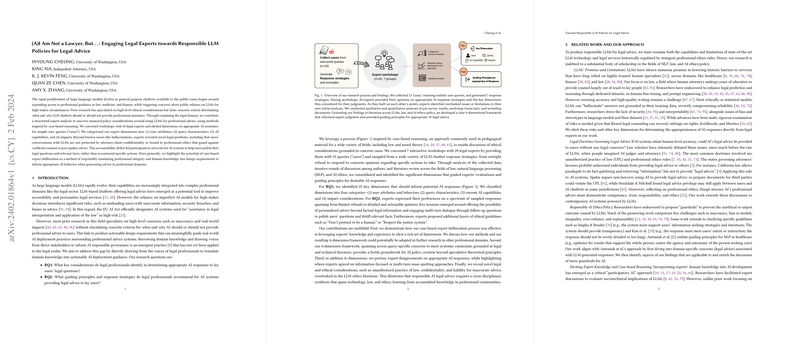The paper "(A)I Am Not a Lawyer, But...: Engaging Legal Experts towards Responsible LLM Policies for Legal Advice" explores the nuanced and complex terrain of using LLMs for providing legal advice. This interdisciplinary research addresses the critical issue of ensuring responsible and ethical deployment of AI systems in the legal domain.
To investigate the circumstances under which LLMs should or should not provide legal advice, the authors engaged in workshops with 20 legal experts. These workshops leveraged methods inspired by case-based reasoning, allowing participants to delve into realistic legal queries, thereby identifying situation-specific concerns as well as broader technical and legal constraints. This methodological approach facilitated an in-depth examination of the contextual factors influencing the appropriateness of LLM responses in legal contexts.
From these workshops, the researchers distilled a four-dimensional framework to guide LLM developers in responsibly structuring AI interactions in the legal domain. The four dimensions are:
- User Attributes and Behaviors: This dimension considers the characteristics and actions of the users seeking legal advice, emphasizing the importance of understanding the user's background, intent, and familiarity with legal concepts.
- Nature of Queries: This dimension addresses the specificities of the legal queries posed to the LLM, including the complexity, specificity, and legal ramifications of the questions.
- AI Capabilities: Here, the focus is on the technical capabilities and limitations of the LLM, stressing the need for developers to calibrate the AI's responses according to its competencies and ensuring that it does not overstep its advisory capacity.
- Social Impacts: This dimension explores the broader societal consequences of deploying LLMs for legal advice, such as the unauthorized practice of law, potential breaches of confidentiality, and the liability implications for providing inaccurate or harmful advice.
Based on these considerations, the experts recommended that LLM response strategies should prioritize helping users formulate appropriate legal questions and identify relevant information sources. Rather than providing definitive legal judgments, LLMs should act as guides to enhance the user's understanding and navigate the legal landscape more effectively.
Moreover, the paper unveiled several novel legal concerns. Among these are the risk of unauthorized practice of law, the importance of maintaining client confidentiality, and the liability issues associated with potentially inaccurate advice. These insights, derived from practice-informed deliberations, highlight gaps in the current literature and demonstrate the benefits of using context-rich methods like case-based reasoning over more abstract or speculative approaches.
In summary, the paper underscores the value of interdisciplinary collaboration and detailed, context-specific analysis in cultivating responsible policies for LLM deployment in sensitive professional domains such as law. The four-dimension framework and the rich qualitative data gathered through expert workshops provide a robust foundation for guiding the ethical and effective use of LLMs in providing legal advice.
